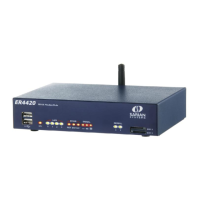SSL Clients parameters
Digi TransPort User Guide 455
SSL Clients parameters
Configuring the SSL clients is performed on the Configuration > Network > SSL page. This page
has a table with columns and parameters as follows:
SSL Client
This column is simply a list of the SSL client numbers supported by the router.
Client Certificate Filename
The name of the required certificate file is selected from those available on the router’s filing
system from this drop-down list.
Client Private Key Filename
The name of the file that contains the private key that matches the public key stored in the
above parameter, is selected from this drop-down list.
Cipher List
The cipher list in this text box is a list of one or more cipher strings separated by colons.
Commas or spaces are also accepted as separators but colons are normally used. The actual
cipher string can take several different forms. It can consist of a single cipher suite such as
RC4-SHA. It can represent a list of cipher suites containing a certain algorithm or cipher suites
of a certain type. For example, SHA1 represents all cipher suites using the SHA1 digest
algorithm. Lists of cipher suites can be combined in a single cipher string using the +
character. This forms the logical AND operation. For example, SHA1+DES represents all cipher
suites containing SHA1 and DES algorithms. If left empty, the cipher list is not used.
For more information see: www.openssl.org/docs/apps/ciphers.html.
Apply to Destination IP Address
Allows the configuration of multiple SSL destinations, each having a different certificate/key
pair. When set, this parameter will lock the SSL client settings to a specific IP address. If this
parameter is left blank, the configured SSL client settings will be used for any connection that
requires SSL. As is usual with the tables on the configuration web pages, the relevant and
appropriate parameters are selected and the Add button on the right-hand side is clicked to
add the entry into the table. Once an entry has been added, it can be removed by clicking the
Delete button in the right-hand column.

